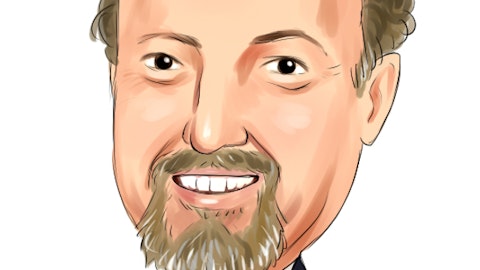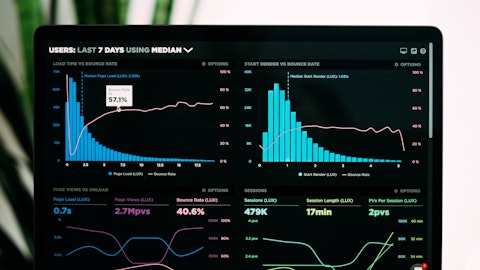And if rates were to remain flat or down a little, or maybe even up a little, which doesn’t look as likely here on the near term — we believe that we’re going to be able to carve a good path for net interest income, a predictable path and that it should be relatively stable based on all these other things.
Dave Rochester: Okay. And then just as a follow-up, how much in the way of the off-balance sheet sweep deposits are there at this point? And is that still an opportunity for you guys to pay down some of the higher cost stuff on balance sheet or is that largely played out at this point?
Paul Burdiss: Well, as I said, the good news is that these, the off-balance sheet, I’ll call them deposits, grew this quarter, I think they’re near $7 billion?
Scott McLean: $7.3 billion.
Paul Burdiss: Thank you, Scott. $7.3 billion. Those are extremely rate-sensitive. And so with the right rate, it’s possible that we can continue to pull some of those on the balance sheet. But I think we’ve managed our deposit portfolio pretty well here over the last couple of quarters. And I feel good about where we’re at, as it relates to the mix of rate and volume. And so I wouldn’t necessarily — fairly be expecting to pull those — continue to pull those on the balance sheet based on our current outlook for funding needs.
Dave Rochester: Okay. Thanks guys.
Paul Burdiss: Thank you.
Operator: Thank you. Our next question will come from the line of Manan Gosalia with Morgan Stanley. Please proceed with your question.
Manan Gosalia: Hi, good afternoon, all. On the deposit portfolio, you just spoke about how it’s very bimodal and the assumption is that the higher beta deposits can reprice relatively quickly. So as we think through rate cuts, and if we can get six or seven rate cuts over the next 18 months or so, would there be a difference in how those rate cuts play through in terms of the benefit? So for instance, would the first few rate cuts be more or less positive than the next few rate cuts?
Paul Burdiss: That’s pretty difficult to predict. I think over time, my point of view is, over time the lower rates are the more — the faster rates kind of hit an implied floor and where that implied floor is — has been reset lower over the last 10 years. But certainly for the first several rate cuts, I would expect particularly, as I said for the sort of very high beta high rate deposits, I would expect that we would be able to follow this down pretty quickly in repricing.
Manan Gosalia: Great. And maybe on the reserves and the ACL ratio, I think you mentioned that it decreased due to a less negative economic outlook. So if you can expand on that and talk about what is embedded into your ACL outlook, and if you think that ACL can come down further from here if a soft landing becomes more and more likely?
Paul Burdiss: Well, yeah, I’ll start with that. We use, as many do, we use an outside resource for the macroeconomic forecasts. And the two key driving components of the allowance for credit losses are the underlying credit quality in the portfolio and migration, whether or not the portfolio is migrating in a way that’s consistent with prior estimates and then the macroeconomic outlook is of course the other piece of that. So, generally speaking, I would say, credit migration is proceeding similar to our expectation. And so the change in the allowance, and it’s a pretty minor change in the allowance, is really based on a slightly better macroeconomic forecast.
Manan Gosalia: Great. Thank you.
Paul Burdiss: Thank you.
Operator: Thank you. Our next question will come from the line of Ken Usdin with Jefferies. Please proceed with your question.
Ken Usdin: Thanks. Good afternoon. Wondering on the earning asset side you mentioned that you do expect earning asset yields to increase throughout the year. Just wondering if last quarter you had talked about like [5 basis points to 10 basis points] (ph) a quarter. And I’m just wondering, just given the rate moves and what’s coming on the books today versus what’s coming off, how much flow-through do you still expect to see as we go forward? Thanks.
Paul Burdiss: Yeah. That’s — Ken, that’s really pretty consistent this quarter. It’s hard to have a lot of insight into what happened more than a couple of quarters out. But our expectation is with — it’s combination of kind of fixed rate paydowns. That’s in the form of loans and investment securities. And then the kind of amortization of swaps, our maturities of swaps, including canceled swaps, those are kind of underwater, based on the original receive pay rate. The combination of all of those things should provide a little bit of lift to earning asset yields for the next couple of quarters. And so it’s consistent with that, [zero to five] (ph) that we expressed last time.
Ken Usdin: Okay, got it. And on the right side of the balance sheet, how much more room do you have? You mentioned that you’re seeing good deposit growth and you’re not expecting much loan growth, securities portfolio is kind of flattish, not shrinking. So how much more can you reduce that reliance on brokered and other wholesale funding from where you were at the end of this year?
Paul Burdiss: Well, yeah, it’s a combination of — as you correctly point out, the securities portfolio is going to continue to amortize away somewhat predictably. As we’ve noted for the last several quarters, loan growth will be the big question mark there in terms of funds needed. But clearly, we’re focused on bringing in customer deposits at a rate that’s lower than kind of alternative wholesale funds. And so to the extent we continue to see that opportunity, we’ll continue to work that.
Ken Usdin: Okay, got it. Thanks, Paul.
Paul Burdiss: Thank you.
Operator: Thank you. Our next question will come from the line of Peter Winter with D.A. Davidson. Please proceed with your question.
Peter Winter: Hi. I wanted to just follow up on John’s question earlier on loan growth, because it is coming in — your outlook is a little bit more cautious than what we’ve heard from other banks. We’ve heard that borrower sentiment has improved a little bit versus 90 days ago and there was an expectation once the Fed starts to cut rates, you should start to see loan demand pickup, line utilization pickup. But you guys are — you’re not thinking that way?





